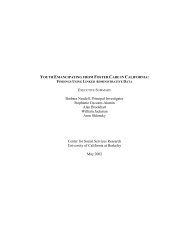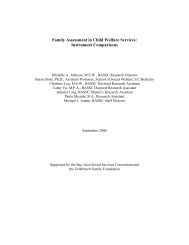Developing a Self-Assessment Toolfor Culturally - Office of Minority ...
Developing a Self-Assessment Toolfor Culturally - Office of Minority ...
Developing a Self-Assessment Toolfor Culturally - Office of Minority ...
You also want an ePaper? Increase the reach of your titles
YUMPU automatically turns print PDFs into web optimized ePapers that Google loves.
limited to the actual clinical encounter. Rather, these measures are meant to capturediverse clinical practices or services, such as alternative or complementary treatments, aswell as awareness, inclusion, or representations <strong>of</strong> cultural differences in the physicalenvironment, dietary options, religious facilities and services, etc. Therefore the term“<strong>Culturally</strong> Inclusive Health Care Environment and Practices” replaced the former (MCOsstudy) term for Domain 3 “Patient Care,” because it better represents what is actuallybeing assessed.2.3 MCOs STUDY INSTRUMENTS REVIEW AND REVISIONWith the refinement <strong>of</strong> the CLAS conceptual framework completed, the next taskwas to review survey questions and response options from the three CLAS in MCOsinstruments to determine the necessary modifications to be applicable to LPHAs. Theproject team and OMH staff held numerous meetings for this purpose. The review processinvolved close inspection <strong>of</strong> each question and its corresponding response options for allthree instrument components. The review <strong>of</strong> the instruments was guided by informationlearned about LPHA characteristics in the literature and from discussions held with PEPand PAG members.Throughout the deliberations at the advisory group meeting, members describedvarious characteristics <strong>of</strong> LPHAs which helped shape the instruments. PEP membersconveyed to the project team that there are diverse management structures which governLPHAs around the country, because states have the authority to organize their ownsystems <strong>of</strong> health care delivery. For instance, some states like New Mexico, have createdLPHA district <strong>of</strong>fices that report directly to the statewide health care system and not to thelocal board <strong>of</strong> health which, in other states, serves as an intermediary betweencommunities and the state. This variability in organizational structure also dictates howLPHAs are staffed. Some LPHAs follow state civil servant laws; some adopt local countyand city hiring procedures; and some hire contract staff. In addition, a LPHA’sorganization and structure shape its funding streams and how it provides training for staff.Advisory group members also discussed the variability in the types <strong>of</strong> individuals whomanage and lead LPHAs. Some LPHAs are headed by a politically appointed individualwho reports to the governor, and other LPHAs are headed by civil servants.LPHAs vary in their size as well. For instance, a LPHA that serves a county mayhave more funds available for staff training compared to a LPHA that serves a small city.As discussed earlier, LPHAs also vary in the types <strong>of</strong> services they provide. Servicesprovided by LPHAs depend on the block grants they currently hold. LPHAs that provideCLAS designate funds for those services from their operating budget, but are notmandated to provide those services by the local board <strong>of</strong> health. Together, these LPHACOSMOS Corporation, December 2003 2-14
















